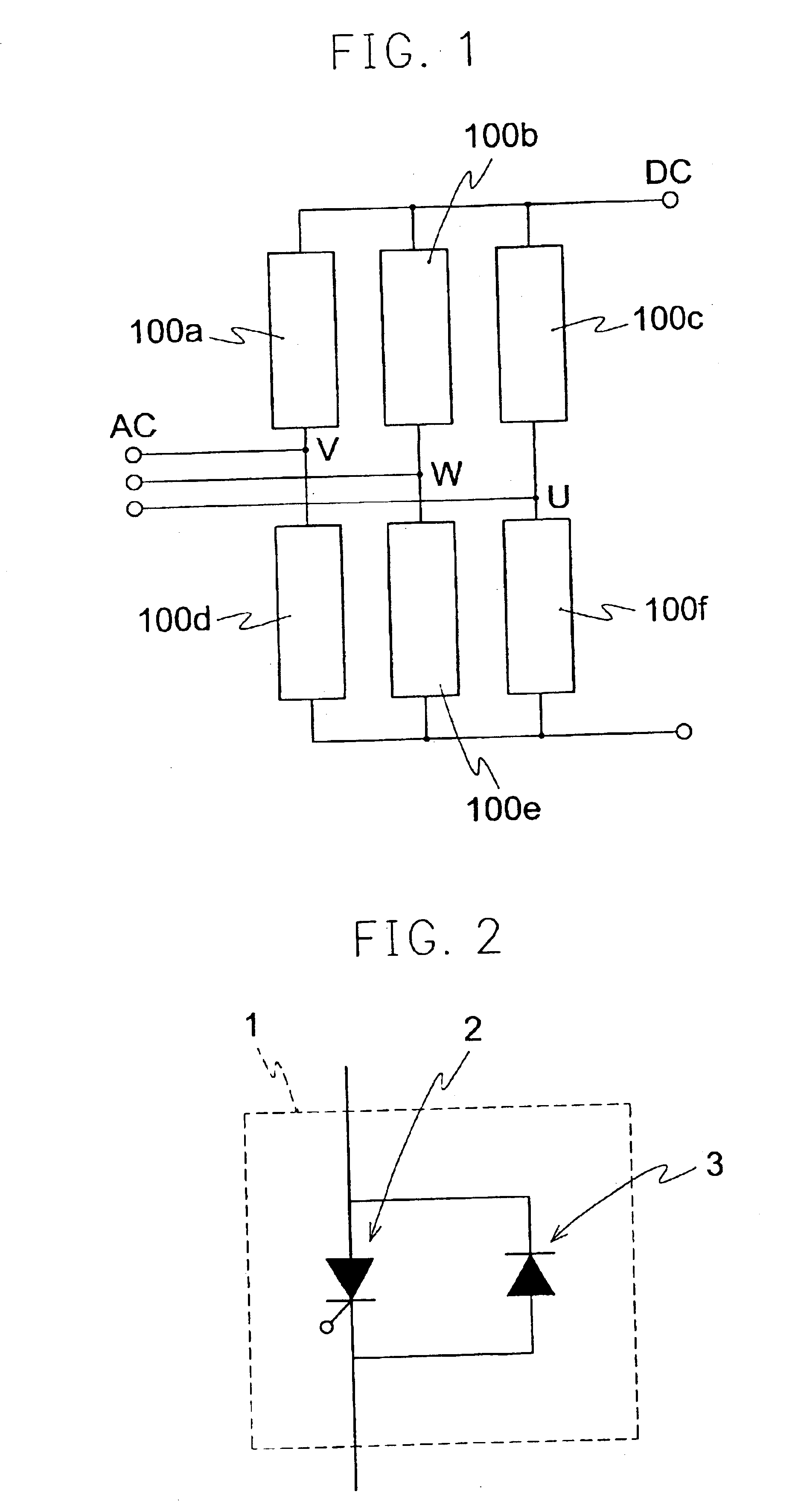Semiconductor switching device
a switching device and semiconductor technology, applied in the direction of overvoltage protection resistors, emergency protective arrangements for limiting excess voltage/current, pulse techniques, etc., can solve the problems of semiconductor element breakdown, semiconductor switching device as a whole becomes complicated, and the manufacturing cost of semiconductor elements rises, etc., to achieve safe and reliable semiconductor switching devices
- Summary
- Abstract
- Description
- Claims
- Application Information
AI Technical Summary
Benefits of technology
Problems solved by technology
Method used
Image
Examples
embodiment 1
[0071]Embodiment 1 of the present invention is described with referring to FIG. 3. A unit in a bridge arm of a semiconductor switching device of the present invention, that is, a series valve with an auxiliary circuit thereof, is shown in FIG. 3. In FIG. 3, 10 denotes a snubber circuit, 16 denotes a non-linear circuit, 4 denotes a first diode, 5 denotes a first capacitor, 6 denotes a first impedance element, 7(7a, 7b) denotes a first Zener diode which is a non-linear resistor element, 8(8a, 8b) denotes a first resistor, 9(9a, 9b) denotes a first controlling semiconductor element, V1 denotes a clamp voltage determined by the first Zener diodes 7a, 7b of the non-linear circuit 16, 2 denotes a semiconductor switching element, 3 denotes a reverse-conducting diode connected parallelly and reversely to the semiconductor switching element 2, and V0 denotes normal divided voltage in which the semiconductor switching element 2 operates. While a IGBT (Insulated Gate Bipolar Transistor) is sho...
embodiment 2
[0082]Embodiment 2 of the present invention is described with referring to FIG. 4. As described above, an accident, such as a short circuit in electric facilities, happens at the supplying side of the semiconductor switching device, voltage of power source rises. As the result of our researches and experiments for various power sources, we have found that the voltage, under the accident, rises to about 1.27 times as high as that without accident at the maximum. Therefore, the clamp voltage V1 is set to be about 1.3 times or higher to the normal divided voltage V0.
[0083]With the clamp voltage V1 about 1.3 times or larger to the normal divided voltage V0, the non-linear circuit 16 is protected from the destruction even the accident happens at the supplying side. Moreover, the clamp voltage V1 can be set to its minimum necessity voltage. In case the clamp voltage V1 is set to about 1.3 times as high as the normal divided voltage V0, the clamp voltage V1 is minimized so that breakdown o...
embodiment 3
[0084]Embodiment 3 of the present invention is described with referring to FIG. 5. As described above, the divided voltage of the semiconductor switching element 2 is higher than the normal divided voltage V0 when the accident happens. As the divided voltage exceeds the clamp voltage V1, current flows through the non-linear circuit 16 and loss, which depends on the current and the clump voltage V1, is caused at the first controlling semiconductor element 9a, 9b. If the loss exceeds the capacity of the first controlling semiconductor element 9a, 9b thermally, the first controlling semiconductor element 9a, 9b is broken. To protect the first controlling semiconductor element 9a, 9b, impedance of the first impedance element 6 is increased in the present Embodiment so that current flowing through the non-linear circuit 16 is decreased, and thereby, the loss at the first controlling semiconductor element 9a, 9b is suppressed below the capacity thereof. At this time, impedance of the firs...
PUM
 Login to View More
Login to View More Abstract
Description
Claims
Application Information
 Login to View More
Login to View More - R&D
- Intellectual Property
- Life Sciences
- Materials
- Tech Scout
- Unparalleled Data Quality
- Higher Quality Content
- 60% Fewer Hallucinations
Browse by: Latest US Patents, China's latest patents, Technical Efficacy Thesaurus, Application Domain, Technology Topic, Popular Technical Reports.
© 2025 PatSnap. All rights reserved.Legal|Privacy policy|Modern Slavery Act Transparency Statement|Sitemap|About US| Contact US: help@patsnap.com



